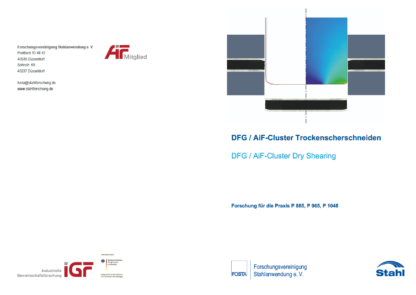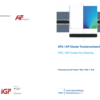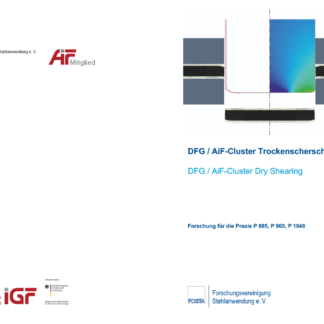Description
P 885, P 965, P 1048 – DFG / AiF-Cluster Dry Shearing
Research results from P 885, P 965 and P 1048
Hybrid composite materials exhibit a broad range of functional properties which can be adapted to the high requirements of new products. They are therefore particularly suitable for the application in lightweight products and as well for many other application fields. However, the lack of serial processing methods prevents the use of such materials in industrial mass products.
Therefore, the shearing process, which is very important for industrial production, has been scientifically investigated within the scope of this AiF/DFG collective research project. The process has been further developed for the cutting of multilayer and two-layered metals as well as polymer laminates. In order to avoid function impairment of the composite, special attention has been paid to the avoidance of delamination, indentation, or tearing of the outer layers during the cutting process. In addition, no additive process-improving lubricants were used to rule out undesired interactions between the polymer layers and the commonly used lubricants as well as their cleaning agents. The aim of the project was, thus, the development of approaches for designing the manufacturing process and the related tool, which will be the basis for the industrial application of dry cutting of different layer composite materials.
To solve the overall problem, two fundamental-oriented DFG projects (DFG I + II) and three application-oriented AiF subprojects (AiF 1-3) dealt different aspects and technological questions on dry cutting as well as with different types of layers.
In every subproject extensive parameter studies were carried out to expand the process understanding with regard to the influence on the cutting forces and the surface quality.
The tests in AiF 1 indicated, amongst others, that the stripping forces can be reduced by the use of lubricant without affecting either the cutting force or the quality of the cutting edge itself. This means that even without applying additional lubricant, the same quality level of the cutting edge can still be expected. The experimental studies in AiF 3 showed that the main influencing parameters on the height of the die-roll are the specimen temperature and the cutting clearance of the die. Indeed, there is a strong dependence of the cutting quality on the respective composite material.
For an objective assessment of the cutting surface quality of the composite materials according to visual and other functional requirements, new special characteristics were defined in addition to the VDI guideline 2906-2. For the analysis of the cutting surface, some common procedures in AiF 2 have been adapted to the characteristics of coated sheet metals. Thus, on the one hand, a simple investigation of the corrosion tendency of the open cutting edges is possible. On the other hand, this will simplify the determination of the optimal material-specific parameter settings (such as cutting parameters, tool adjustment).
For the analysis of the intersections in sandwich materials, several non-destructive test principles for delamination detection were qualified in AiF 3. Another focus of the research was the analysis of the wear mechanisms depending on the material type and the process control. The share of tribo-chemical wear in tool and ist mechanisms were determined using specific gas-tight equipment which was developed in DFG I. In addition, all subprojects carried out durability tests to determine the wear behavior of the cutting tools under various boundary conditions. As expected, tool wear is highly dependent on the tribological system. However, the pre-lube of the metal sheets (in delivery state) already causes a noticeable reduction of wear at the cutting tools. When cutting completely cleaned dry sheet metal, a strong adhesion tendency on the cutting punch was detected. By applying appropriate tool coatings, galling on the punch can be prevented and a significant increase of the tool life can be achieved. Parallel to the experimental investigations, model approaches were developed in the DFG subprojects for the robust design and optimization of the cutting process and the tools.
DFG I developed a coupled cutting and wear simulation. The simulation of the cutting process is based on the modeling of the material separation of each component under shear by coupled, continuum-mechanical damage models. The numerically computed load collectives (contact pressure and relative speed) are the input data for the phenomenological wear simulation based on the Archard model, which can predict both the abrasive wear and the tribo-chemical wear. The comparisons between the simulation results and the executed experimental investigations in the AiF projects have shown good qualitative prediction of the punching force for complex composite material. A further improvement of the prediction accuracy can be achieved by a more complex characterization and modeling of the polymer materials. The prediction of the software tool for the tool edge wear showed a good agreement with the experimental results for monolithic sheet metals. A parameterized analytical model was also developed in DFG II for shear cutting of sandwich material by which the expected processing forces and, in particular, their progression can be predicted. The developed model can also be used to investigate the material combination for sandwich sheet materials in relation to their shear-cut-ability.
Finally, by optimizing and adapting the tools and the process control based on the results obtained by experiments and simulations, an optimal cutting result and the lowest possible wear of the tool during dry cutting of the considered composite type were obtained. The burr height and the delamination behavior on the composite are considered as the quality criteria. In case of pre-coated materials, overlaying the cutting surface is desirable to increase the corrosion resistance of the part. For sandwich materials, the compression or the pulling out of the soft core material must be prevented. It was discovered that for sandwich plates an optimal cutting surface can be obtained by implementing the extended counter cutting process with the superposition of additional compressive stresses in the shearing area, which was developed in DFG II.
At the end of the AiF/DFG joint research project the results were consolidated in guidelines and methods for the robust design of a dry cutting process of hybrid composite materials. This can be used for series-oriented further development of the concepts. The findings gained from these research activities are highly innovative since the dry cutting of various metallic layer composites has been systematically investigated for the first time. The project results provide a basic principle for future development projects to enable the use of further composite materials in industrial mass products.
Main content only available in german language.
Published in:
April 2020
Involved Institutes:
Technische Universität Dortmund, institute of forming technology and lightweight components
Technische Universität Darmstadt, Institute for Production Engineering and Forming Machines
Technische Universität München, Chair of Metal Forming and Casting




